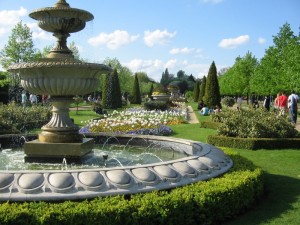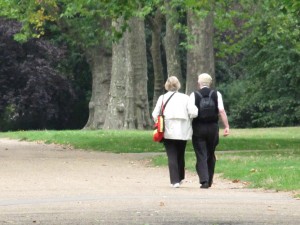September 21st, 2010 · No Comments
From what I’ve begun to gather, the English (or, Londoners) aren’t particularly fond the French or French culture. I overheard a conversation on the street that ended in, “Do I look bloody French to you?”. Not quite sure of the motivation behind the outburst, but anti-French sentiment, while not rampant, is a visible part of popular English culture. It’s strange, then, that some of London’s most prominent physical elements should mesh so completely with the French formal ideal: parks.
The classic French conception of beauty in nature is that none can exist without the existence of order- of the human hand altering the chaotic natural mass into a structured, geometric product. From what I’ve seen of the layout of Regent’s park, the Brits have just about the same idea. Many people have commented that parks in London seem to be, first and foremost, places to enjoy the beauty of the precisely-planned horticulture. We see meticulously trimmed hedges, flowers planted with regard to color scheme, and white fountains as centerpieces. While running in Regent’s the other afternoon, I saw teams of gardeners replacing soil and adjusting flowerbeds. The beauty lies not only in pure nature, but in the reordering and distribution of it.

http://www.gardens-to-visit.com/2009/02/versailles-2.html
It’s hard to think of a better example of this systematic restructuring than in Versailles. The hedges are pruned to an almost impossible degree of uniformity, the flowers are separated with care, and there are man made monuments throughout (to serve as an even more solid testament to the strength and genius of the designers. The same artistic values and technical skill are visible in Queen Mary’s Garden in Regent’s park.

http://www.londonrelocationservices.com/blog/tag/west-london-relocation
The rows and rows of flowers in the garden do not grow in natural patterns, as might be typical in American parks or gardens. Like their French counterparts, the English gardeners have devised color schemes, strict rows, and tight upkeep standards on all the elements of the space (note the uniformity in the hedges around the fountain and the flower patches). These areas of the park are not meant for “fun” in the typical American park sense of the word- we were glared at for tossing a frisbee in the garden a few days ago. They’re a medium of artistic expression, and I’m starting to appreciate them more and more. I do think, however, that instead of badmouthing the French, Londoners should take some time to stop and smell the roses. It’s through these gardens that we can see real, fundamental similarities in an important aspect of the two cultures.
Tags: 2010 Patrick · Uncategorized
September 19th, 2010 · No Comments
The parks in London, as people have already noted, are places of beauty and enjoyment. Yet, they are not all created equal, well, no, used equally. When relaxing in various ones, I noticed that some were more touristy. In fact, within some, one area was more likely to be touristy that an other.
My first introduction to a London park was when we had class in Russell Square. Clearly, people weren’t used to seeing a group of students (much less Americans) in August discussing various ideas about immigration. Yet, I can’t imagine being at UCL and not using the space for at least small study groups, if not classroom discussions when the weather turns nice.
I adore the idea of small squares littered throughout the city ready for use whenever someone wants an escape from the business and chaos of the city. Of those I noticed, the squares I most wanted to go into were locked and only accessible by the area’s residents. I have mixed feelings on this. On one hand, it’s great for residents to have a safe place to go with their young children or a quiet place where they don’t have to worry about tourists wandering through talking loudly (oops). On the other, why shouldn’t these spaces be opened up for everyone? It feels like one more thing that add to English hypocrisy: they want to pretend when it’s convenient that class doesn’t count, but it seems to exist in these situations when the restricted squares seem to be in areas where income looks to be higher.
For the actual parks, my favorite has been Kensington Gardens. I loved the duality of the park: one side was quiet and peaceful and the other was busy, well, as busy as a park can be. Residents played with their dogs as tourists wandered through taking photos and trying to find the actual park, Hyde Park. Hyde Park was also rather enjoyable, but was far busier on the day I visited. Granted, searching for the Peter Pan statue also lends the visit to being centered around the busier areas. I enjoyed walking through Kensington and observing people and how they interacted with the space (mostly walking their dogs or playing fetch with them, as well as a few taking their young children out for a walk). In Hyde I felt like I was only there to check it off of my list of “Things To Do in London.”

Regent’s Park, while a lot like Hyde in some regard also demonstrated this dualistic atmosphere. The park seemed to have a few tourists wandering through (especially as you got closer to the Zoo and in the more French style areas), but it also had a lot of Londoners, some out walking and others with their family (or dogs). I much preferred the areas that were mostly charming (and alarmingly uneven) paths, where others were walking with their dogs. The other thing that I liked about Regent’s was how family friendly it was. There was a playground that was obviously popular among families with young children.
I’ve enjoyed the parks that I’ve visited and they’ve helped convince me that London is actually my favorite city in the world because of their place in the life of the average Londoner (or student visiting for the month): they’re key to staying sane here. I thrive on the chaos of the city, but sometimes nothing is better than a quiet stroll through a park or an hour reading in a square. I hope that as I venture to other places in England that I will be able to go to a few other cities’ gardens/squares/parks and see how they differ.
Tags: 2010 Stephenie



